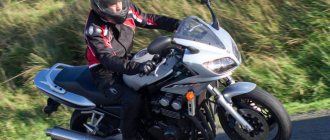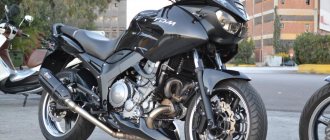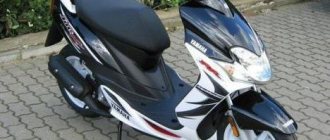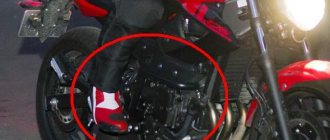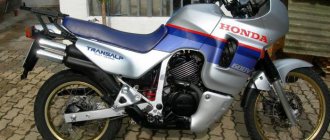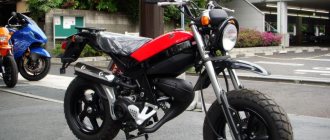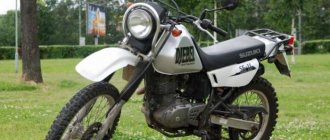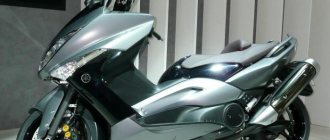The debut of the Yamaha Phaser 600 motorcycle took place in 1997 at the Paris Motor Show. The appearance of this bike gave a powerful impetus to the development of the market for powerful neoclassics with a medium engine capacity. This model combined the comfort of a classic motorcycle, the agility and maneuverability of a sport, and a stylish modern design.
The Phaser was produced until 2004, when European environmental standards were revised. The bike did not meet the new stricter standards, so the manufacturer had to take a number of measures aimed at modernizing the engine and minimizing emissions into the atmosphere. As a result, a new generation of bikes was born - the Yamaha FZ6.
Production chronology
The motorcycle officially began mass production in 1998. It was aimed both at the domestic market of Japan and the markets of Europe and the USA. In 2000, the motorcycle underwent a number of upgrades. The result was a new seat design, the introduction of fork preload adjustment, and an increase in the fuel tank from 18 to 20 liters.
In 2002, the manufacturer carried out a large-scale restyling of the model. The design of the front built-in fairing, gas tank, and dashboard has changed. In 2004, serial production of the Yamaha Phaser 600 motorcycle was discontinued. It was replaced by a new bike built on its basis - the Yamaha FZ6.
Brief history of the model
Model:
Yamaha FZ1 (FZS1000N/NC) USA.
Model:
Yamaha FZS1000 Fazer (Europe).
Model code:
5LV1, 5LV2, 5LV3, 5LV6.
Model:
Yamaha FZ1 (FZS1000P/PC) USA.
Model:
Yamaha FZS1000 Fazer (Europe).
Model code:
5LV8, 5LV9, 5LVA, 5LVD.
Model:
Yamaha FZ1 (FZS1000R/RC/SPR) USA.
Model:
Yamaha FZS1000 Fazer (Europe, South Africa).
Model code:
5LVF, 5LVH, 5LVN, 5LVP, 5LVR, 5LVG, 5LVM, 5LVU.
Model:
Yamaha FZ1 (FZS1S/SC) USA.
Model:
Yamaha FZS1000 Fazer / FZS10S (Europe, South Africa).
Model code:
1C21, 1C23, 1C27, 1C25, 1C26, 1C22, 5LVY.
Model:
Yamaha FZ1 (FZS1T/TC, FZ1T/TC) USA.
Model:
Yamaha FZS1000 Fazer / FZS1000S/T (Europe).
Model code:
1C2B, 1C29, 1C2A, 1C28, 1C2F.
Model:
Yamaha FZ1 (FZS10V/VC) USA.
Model:
Yamaha FZ1-N / FZ1-S Fazer (Europe, Australia).
Model code:
3C38, 3C37, 3C39, 3C32, 3C33, 3C31, 2D12, 2D13, 2D11, 3C36.
Model:
Yamaha FZ1 (FZS10W/WC) USA.
Model:
Yamaha FZ1-N / FZ1-S/SW Fazer (Europe, Australia).
Model code:
3C3C, 3C3B, 3C3A, 2D19, 2D18, 2D17, 2D16, 2D15, 2D14, 5D01, 5D02, 3C3F.
Model:
Yamaha FZ1 (FZS10XCR/XCGY) USA.
Model:
Yamaha FZ1-N / FZ1-S/SX Fazer (Europe, Australia, Japan).
Model code:
3C3K, 2D1G, 2D1D (Australia); 3C3J, 3C3H, 2D1F, 2D1E, 2D1C, 2D1B, 22C4, 22C3, 22C2, 22C1, 5D04, 5D03, 3C3N (Europe); 3C3G, 2D1A (Japan).
Model:
Yamaha FZ1 (FZS10YL/YCL, FZS10YG/YCG) USA.
Model:
Yamaha FZ1-N / FZ1-S/SY Fazer (Europe, Australia, Japan).
Model code:
3C3S, 2D1P, 2D1L (Australia); 3C3R, 3C3P, 2D1N, 2D1M, 2D1K, 2D1J, 22C8, 22C7, 22C6, 22C5, 5D05, 5D06, 3C3V (Europe); 3C3W (Japan).
Model:
Yamaha FZ1 (FZS10ZR/ZCR, FZS10ZB/ZCB) USA.
Model:
Yamaha FZ1-N/NA, FZ1-S/SA Fazer (Europe, Japan).
Model code:
1CA4, 5D09, 5D07, 3C3X, 1CA5, 22CB, 22C9, 1D1U, 2D1R (Europe); 1CA8, 2D1X (Japan).
Model:
Yamaha FZ1 (FZS10AS/ACS) USA.
Model:
Yamaha FZ1-N/NA, FZ1-S/SA Fazer (Europe, Japan).
Model code:
1CAE, 5D0D, 5D0B, 1CAF, 1CA9, 22CD, 1EC1 (Europe); 1CAJ (Japan).
Model:
Yamaha FZ1 (FZS10BW/BCW) USA.
Model:
Yamaha FZ1-N/NA, FZ1-S/SA Fazer (Europe, Japan).
Model code:
1CAS, 5D0F, 1CAK, 22CF, 1EC4 (Europe);
1CAU, 1CAT, 1EC8, 1EC7 (Japan).
Model:
Yamaha FZ1 (FZS10D/DC) USA.
Model:
Yamaha FZ1-S Fazer (Europe, Japan).
Model code:
1CAY (Europe); 2DV2 (Japan).
Model:
Yamaha FZ1 (FZS10EW/ECW, FZS10E/EC) USA.
Model:
Yamaha FZ1 (FZS10FGY/FCGY) USA.
Frame numbers of different generations of the Yamaha FZ-1 model:
| Year of issue | Frame number |
| 2001-2002 | RN06x |
| 2003-2004 | RN07x |
| 2005 | RN14x |
| 2006 | RN16x, FZ1 Fazer – RN17x |
| 2007 | RN17x |
| 2008- | RN21x |
Peculiarities
The Yamaha Phaser 600 model is equipped with an engine from the YZF600R Thundercat sports tour. Of course, it has undergone significant reconfiguration. This made it possible to increase torque at medium speeds. As a result, the engine began to produce 95 hp. With. power at 61.2 Nm of torque, and the maximum performance of the bike was achieved at 9500-11500 rpm. The bike received reliable front brakes from the sports model YZF-R1.
Another notable feature of the Yamaha FZS 600 Fazer is the presence of a built-in fairing above the headlight. The motorcycle frame is made of steel and is quite laconic. The suspensions can be adjusted for preload.
Yamaha motorcycles
…
| YZF-R1 | |
| engine's type | Liquid-cooled, 4-stroke, forward-leaning inline |
| Engine capacity | 998 cm3 |
| Engine power | 182 hp |
Characteristics of “Yamaha YZF-R1”
| YZF-R6 | |
| engine's type | Liquid cooled, 4-stroke, forward inclined, in-line |
| Engine capacity | 599 cm3 |
| Engine power | 120 hp |
Characteristics of “Yamaha YZF-R6”
| FZ8 | |
| engine's type | Liquid cooled, 4-stroke, forward-leaning inline 4-cylinder, DOHC |
| Engine capacity | 779 cm3 |
| Engine power | 106 hp |
Characteristics of “Yamaha FZ8”
| FZ8 Fazer / ABS | |
| engine's type | Liquid cooled, 4-stroke, forward-leaning inline 4-cylinder, DOHC |
| Engine capacity | 779 cm3 |
| Engine power | 106 hp |
Characteristics of “Yamaha FZ8 Fazer / ABS”
| Star Roadliner 1850 | |
| engine's type | Air-cooled, 4-stroke, V-twin, 2-cylinder, OHV, 4-valve |
| Engine capacity | 1854 cm3 |
| Engine power | 90 hp |
Characteristics of the “Yamaha Star Roadliner 1850”
| FZ1 | |
| engine's type | Liquid cooled, 4-stroke, forward-leaning inline 4-cylinder, DOHC |
| Engine capacity | 998 cm3 |
| Engine power | 150 hp |
Characteristics of “Yamaha FZ1”
| FZ1 Fazer / ABS 2011 | |
| engine's type | Liquid cooled, 4-stroke, forward-leaning inline 4-cylinder, DOHC |
| Engine capacity | 998 cm3 |
| Engine power | 150 hp |
Characteristics of “Yamaha FZ1 Fazer / ABS 2011”
| XJ6 Diversion/ABS | |
| engine's type | Liquid cooled, 4-stroke, forward-leaning inline 4-cylinder, 4-valve, DOHC |
| Engine capacity | 600 cm3 |
| Engine power | 78 hp |
Characteristics of “Yamaha XJ6 Diversion / ABS”
| XJ6 | |
| engine's type | Four-stroke, in-line, four-cylinder, forward-leaning, four valves per cylinder and two overhead camshafts |
| Engine capacity | 600 cm3 |
| Engine power | 78 hp |
Characteristics of “Yamaha XJ6”
| XV 1900 Midnight Star | |
| engine's type | V2 |
| Engine capacity | 1854 cm3 |
| Engine power | 99 hp |
Characteristics of the “Yamaha XV 1900 Midnight Star”
| XV1900A Midnight Star(Stratoliner) 2009 | |
| engine's type | Twin-cylinder V-shaped 4-stroke |
| Engine capacity | 1854 cm3 |
| Engine power | 90 hp |
Characteristics of “Yamaha XV1900A Midnight Star(Stratoliner) 2009”
| FJR1300A | |
| engine's type | Inline four-cylinder, four-stroke, forward-leaning, liquid-cooled, dual overhead camshaft (DOHC) |
| Engine capacity | 1298 cm3 |
| Engine power | 144 hp |
Characteristics of “Yamaha FJR1300A”
| FJR1300AS | |
| engine's type | Inline-four, four-stroke, forward-leaning, liquid-cooled, DOHC engine |
| Engine capacity | 1298 cm3 |
| Engine power | 144 hp |
Characteristics of “Yamaha FJR1300AS”
| YZ250F | |
| engine's type | Four-stroke, DOHC, 5 valves, one cylinder |
| Engine capacity | 250 cm3 |
| Engine power | 36 hp |
Characteristics of “Yamaha YZ250F”
| YZ250 | |
| engine's type | Liquid Cooled, Push-Pull, Reed Valve, Single Cylinder Forward Tilt, YPVS System |
| Engine capacity | 249 cm3 |
| Engine power | 29 hp |
Characteristics of “Yamaha YZ250”
| YZ125 | |
| engine's type | Air cooled, 2-stroke, with reed valve |
| Engine capacity | 124 cm3 |
| Engine power | 37 hp |
Characteristics of “Yamaha YZ125”
| FZR1000 Genesis (1987) | |
| engine's type | 4-stroke, 4-cylinder, liquid cooled |
| Engine capacity | 989 cm3 |
| Engine power | 135 hp |
Characteristics of “Yamaha FZR1000 Genesis (1987)”
| XT1200Z Super Tenéré | |
| engine's type | Liquid cooled, 4-stroke, DOHC, forward-leaning inline 2-cylinder, 4-valve, fuel injection, 2 spark plugs per cylinder |
| Engine capacity | 1199 cm3 |
| Engine power | 110 hp |
Characteristics of the “Yamaha XT1200Z Super Tenéré”
| XT660Z Tenéré | |
| engine's type | Liquid cooled, 4-stroke, 4-valve, single cylinder, SOHC |
| Engine capacity | 660 cm3 |
| Engine power | 48 hp |
Characteristics of the “Yamaha XT660Z Ténéré”
| WR250R | |
| engine's type | Liquid cooled, 4-stroke, forward-leaning single cylinder, 4-valve, DOHC |
| Engine capacity | 250 cm3 |
| Engine power | 31 hp |
Characteristics of “Yamaha WR250R”
Design
"Yamaha-Phaser 600" was created in the best traditions of neoclassics. Unencumbered by unnecessary plastic, it looks a bit like a naked bike. The fairing with paired headlights, the shape of the saddle with a rear grab handle for the passenger and the raised exhaust pipe with a powerful muffler give it the features of a sportbike. Overall the design is functional.
The appearance of the motorcycle seems to speak of its dynamic character, which is fully confirmed by the performance characteristics. This bike fits perfectly into the general style of a modern metropolis and often becomes the choice of young and active people.
Design solutions
The appearance of the Yamaha Phaser 600 was in perfect harmony with the stated characteristics.
Every line, curve and design element literally “screamed” about the swiftness and agility of the “steel horse”, fitting perfectly into the original concept of “comfort + versatility”.
The size of the bike allows it to feel great in heavy traffic:
- length - 209.5 cm;
- height - 108.5 cm;
- width - 75.5 cm;
- saddle height - 79.5 cm;
- wheelbase - 144.0 cm;
- ground clearance - 14.5 cm.
Among other things, 17-inch wheels (110/70-ZR17 front and 160/60-ZR17 rear), as well as almost ideal weight distribution along the axles (49 to 51%) add to the maneuverability of the 180-kilogram car.
The high saddle of the motorcycle is ideal for a rider of average height.
Its width allows you to sit with maximum comfort, and the footrests under the seat allow your limbs to be found intuitively.
The paired headlights look like the squinting of a cat's eyes and organically harmonize with other design solutions, while at the same time doing an excellent job with their main task.
A chrome exhaust muffler, a tinted windshield, neat rear-view mirrors, an original-shaped tank and an informative dashboard complement the image of a universal car.
In 2000, the Phaser 600 model underwent modernization aimed at increasing comfort during long journeys. As a result, the motorcycle received an enlarged (up to 20 liters) gas tank. A thicker seat, dual odometer (daily trip), dashboard clock, updated passenger handles, emergency stop signal, improved brakes and other suspension tweaks.
A couple of years later (2002), the tank was enlarged again, stainless steel pipes were installed, the dashboard and fairing were updated, fitting the motorcycle to the updated style of the brand and giving it a more modern look.
"Yamaha-Phaser 600": technical characteristics
The motorcycle has relatively small dimensions: 2080 mm in length, 710 mm in width and a seat height of 790 mm. Dry weight is 189 kg.
To what speed can a Yamaha Phaser 600 motorcycle be accelerated? Reviews indicate that he can even handle 210-215 km/h. And he reaches a hundred in just 3.8 seconds.
Particular attention should be paid to the motor. It is 4-stroke, has 4 cylinders installed in a row. Liquid cooling type. This engine is capable of accelerating to 11,500 rpm and producing 95 hp. With. Multi-disc clutch. The gearbox has 6 stages.
It is worth mentioning the features of the chassis. The telescopic fork is tilted 24° and moved forward 88 mm. A monoshock absorber is installed at the rear.
Assembly and commissioning are no problem. The Yamaha Phaser 600, whose manual is written in Russian, needs to be run in at low speeds and idle speeds. Of course, only those who buy a new motorcycle from a dealership should know this.
Video
Yamaha FZS 600 Fazer
was produced from 1998 to 2004, when it was replaced by a more modern model - the Yamaha FZ6. This urban motorcycle, clad in plastic, is a fairly typical representative of its class. The common engine capacity is 600 cc. see, good characteristics and a fairly modern appearance by the standards of that time made the model very popular. And even now the FZS 600 does not lose its relevance, enjoying good popularity among Russian bikers for its low price, however, inferior in demand to its descendant - the FZ6.
The engine for the Yamaha FZS 600 was the power unit from the Yamaha YZF600 Thundercat sportbike. The liquid-cooled inline-four from the Thundercat was derated, resulting in a reduction in power to 95 horsepower and a torque of 61 nM. The sporting roots of this engine, however, are also felt in the FZS 600 with a minimum of electronics, so that when the gas is opened sharply, a noticeable kick followed by powerful acceleration is guaranteed to the owner.
Being a completely average urban classic, the Yamaha FZS 600 has a perky character. However, from a purely technical point of view, this motorcycle is nothing outstanding - four carburetors, liquid cooling, chain drive and a six-speed gearbox. The frame is the simplest, steel. All versions also had a plastic fairing installed, which copes well with wind pressure up to 120-140 km/h. The FZS 600 was produced in this form until 1998, when the 18-liter gas tank was replaced with a 20-liter one, and in 2002 a deep restyling of the exterior was carried out, as a result of which the bike began to look like the FZ6-S later looked like.
Possessing a truly explosive character, the motorcycle is capable of accelerating from 0 to 100 km/h in 3.3 seconds, and the maximum speed of the Yamaha FZS 600 is about 220 km/h, that is, comparable to the modern Yamaha MT-09. With such frantic dynamics, good brakes came in very handy - in particular, the front brakes came from the Yamaha R1, a world-famous sportbike. Their efficiency is beyond all praise. They also took care of the suspension - it is no frills, but it is fully adjustable for preload, both front and rear. The driving position on the FZS 600 is upright, but if desired, you can move back in the seat and lie on the tank, hiding behind the fairing.
The dry weight of the Yamaha FZS 600 is about 190 kg - quite average figures by the standards of the class. The motorcycle only seems heavy when static, because as soon as you start moving, it starts to be controlled as easily as a feather. Control obedience largely depends on the suspension settings - if you relax them, then during sharp maneuvers the motorcycle will obey slightly reluctantly, with some delay, but in the “hard” steering mode the FZS 600 obeys perfectly.
Of course, this is a city motorcycle, but the large gas tank and adequate protection from headwinds make it suitable for long trips. In addition, no one forbids installing a higher windshield and travel luggage bags on it. The seating position on the Yamaha FZS 600 is, of course, quite “collected” and tight, but the seat is spacious, which allows you to change your body position from time to time. All this makes this bike a shining representative of its generation, and it is not surprising that the Yamaha FZ6 turned out to be so similar to it. Japanese designers simply took the FZS 600 design, which was successful in many respects, and made it even better.
The target audience
Universal, like most classics, the Yamaha Phaser 600 is often the choice of those who suffer from motorcycle disease in the broadest sense of the word. The owner of this bike is not averse to sometimes driving around the city, he values his time and does not like to get stuck in traffic jams, he is easy-going, so on weekends he can go to a neighboring city or ride around the surrounding area.
Of course, by and large, this is transport for the city. But the Yamaha Phaser 600, whose characteristics are perhaps the most impressive in its class, feels great both on a long trip and in a suburban setting.
Often this model becomes the choice of those who are fed up with racing and cross-country terrain, and yesterday’s fans of enduro and sports switch to it. It is especially suitable for those who plan to ride with a passenger. The rear seat is quite practical, and the grab handle significantly increases the level of comfort. Of course, there are those who don’t like the handle behind the saddle at all, however, firstly, it can be easily removed, and secondly, the advantages of the motorcycle completely cover this minor feature.
Fans of alterations are also turning their attention to the Phaser. The design and characteristics of this bike allow your imagination to run wild.
Estimated cost
Today, the Yamaha Fazer 600 model has been discontinued, so purchasing a brand new motorcycle, the main highlight of which was practicality and reliability, is quite problematic.
However, the secondary car market offers the motorcycles in question in fair quantities. The price, of course, depends on the condition and mileage of the equipment, but rarely falls below 200,000 rubles.
A good representative of the Enduro class is the Japanese motorcycle Suzuki Djebel 200.
We also recommend paying attention to bikes from English manufacturers Triumph. You can familiarize yourself with the model range in more detail here.
Tuning and customization
The basic equipment of the motorcycle impresses even the most experienced. Fans of the Phaser note in reviews that it has a very convenient central stand, rather than a one-sided stand; well-designed tidy; ergonomically located controls.
Those who like to squeeze maximum speed out of their motorcycle often get a larger sports windshield that protects the pilot from oncoming air currents. As always, heated steering grips are relevant.
Those who do not plan to ride with a second number often get rid of the passenger seat. This simplifies the design and makes the silhouette even more dynamic and aggressive.
Yamaha Phaser 600 motorcycles simply attract fans of street fighters. Indeed, they make excellent custom devices. To do this, the Phaser loses its front fairing, all the plastic body kit that can be removed, acquires an impressive muffler and a huge number of external effects. Its iron interior, which the manufacturer does not hide under the casing, looks even more impressive having passed through the skillful hands of an experienced customizer.
Video
- Review of the Yamaha YZF600R Thundercat motorcycle.
- Review of the Yamaha YZF600R Thundercat motorcycle.
Yamaha YZF600R Thundercat
- a motorcycle with a big name and a glorious history. In the CIS countries, it is still popular for its good driving characteristics, despite the fact that it has been discontinued for a long time, and the nickname “Gromokot” has firmly stuck to it, which is, in fact, a copy of the original name. Be that as it may, this sportbike is very interesting in our time, despite the fact that from a technical point of view it is inferior to its descendants in all respects. And during the years of its production it did not shine with any innovative technical solutions, which did not prevent it from becoming very popular.
The Yamaha YZF600R Thundercat was produced from 1996 to 2004, and despite the fact that this model was developed as a pure sportbike, it turned out to be excellent for fairly short trips, so many owners use it as a sports tourer, and consider it the motorcycle is exactly for this class. It should be noted that the YZF600R Thundercat lost its position as a radical sports bike after the advent of new generation sports motorcycles, more modern and powerful, but it remains relevant to this day.
Having replaced the obsolete Yamaha FZR 600R on the assembly line, the new model was to the taste of customers. The designers inserted a heavily redesigned liquid-cooled inline-four from the aforementioned FZR 600R into the steel frame (deltabox type) of the motorcycle, which after all the modifications significantly increased power and torque. The frame, by the way, is also actually a heavily redesigned frame from its predecessor, as is the aluminum swingarm. As a result, the YZF600R Thundercat turned out to be heavier than the FZR600R, but noticeably more powerful.
Externally, the Yamaha Thundercat resembles its older brother - the YZF1000R Thunderace model, and since the design of motorcycles from this manufacturer has always been their strong point, the Thundercat looks nice and attractive even now. An interesting technical solution was the installation of inertial charging, thanks to which engine power increases with increasing speed. The motorcycle also gets excellent brakes from the YZF1000R.
The brakes, by the way, were just right - the Gromokot is distinguished by impressive dynamics and frantic acceleration. Its 16-valve engine develops a power of 100 hp. (at 11,500 rpm) and is capable of accelerating the motorcycle to an impressive 260 km/h. not bad for a sporty 600 developed several decades ago, right? Moreover, the detonation when opening the gas is very noticeable - this is due to the carburetor power system and the lack of high-tech “gadgets” in the engine. However, its perky character is one of the reasons why the Yamaha YZF600R Thundercat is still so loved by an entire army of fans.
Of course, in the 2000s, “Gromokot” began to yield to more modern competitors, but, as we said above, many motorcyclists fell in love with it as a sport-tourist. This is due to the softness of its suspensions - they are definitely not stiff enough for aggressive driving on the track, but they are excellent for long trips on Russian asphalt. The comfortable dual seat of the Yamaha YZF600R Thundercat allows both the driver and the passenger, if equipped, to sit comfortably. A gas tank with a volume of 19 liters provides a good power reserve - at a speed of 120-130 km/h, the motorcycle fits into 6 liters of gasoline, although the exact consumption value also depends on the technical condition of each specific motorcycle.
Thus, the motorcycle, discontinued back in 2004, is still very popular in the secondary market. It boasts impressive power, a comfortable chassis, excellent, without exaggeration, brakes and a solid power reserve. It is not surprising that many Yamaha Thundercats are still roaming the roads - the motorcycle, according to reviews, is very reliable, so this model will continue to be on sale.
Prices
Today, finding a new Phaser 600 is quite difficult. Still, many years have passed since it stopped being produced. Mostly this model can be found on the secondary market. When purchasing, be sure to discuss the possibility of a test drive and be prepared to spend $2,500-3,500 on the device.
Spare parts that Yamaha produces for its own motorcycles can be found almost everywhere today. In addition, there is a huge selection of analog spare parts from other manufacturers with less famous names. Of course, the original will cost more.
The lineup
The Yamaha snowmobile lineup includes:
Viking
Description and technical characteristics of the Yamaha Viking-540 snowmobile (professional):
Overall width - 1.19 m
Also on the market is the Yamaha Viking Professional VK540E snowmobile model, equipped with a two-stroke engine.
Technical characteristics of the Ventura sports snowmobile:
Description and characteristics of the Yamaha Venture Multi Purpose snowmobile:
Technical parameters of the Bravo-250 modification:
Phaser model parameters:
Technical parameters of the Nitro model:
Exhaust system - 2
Parameters and performance of the children's snowmobile SRX-120:
Fuel consumption
Phaser's appetites are quite average. The manufacturer claims 5.1 liters per hundred. Owner reviews say that the actual average fuel consumption is about 6 liters. Of course, under some “aggravated circumstances” it can increase significantly and reach 8-9 liters.
Keep in mind that, like most Yamaha motorcycles, the Phaser 600 prefers to be powered by high-quality gasoline. You should not take risks with cheap fuel of questionable quality, as this can shorten the service life of the device.
Brief history of the model
Model
: Yamaha Thundercat 600 (1st generation) (Europe, North America).
Factory designation
: 4NA1, 4NC1, 4ND1, 4NE1.
Model
: Yamaha Thundercat 600 (1st generation);
Yamaha Thundercat 600 (II generation) (Europe, North America). Factory designation
: 4NA2, 4NC2, 4ND2, 4NE2; 4TV1, 4TV2, 4WD1, 4WE1, 4WF1.
Model
: Yamaha Thundercat 600 (Europe, North America).
Factory designation
: 4EW2, 4TV3, 4WE2, 4WF2, 5AH1, 5AH2.
Model
: Yamaha Thundercat 600 (Europe, North America).
Factory designation
: 4TV5, 4TV6, 4WD3, 4WE3, 4WF3, 5AH3, 5AH4.
Model
: Yamaha Thundercat 600 (Europe, North America).
Factory designation
: 4TV7, 4TV8, 4WD4, 4WE4, 4WF4, 5AH5, 5AH6.
Model
: Yamaha Thundercat 600 (Europe, North America).
Factory designation
: 4TV9, 4TVA, 4WD5, 4WE5, 4WF5, 5AH7, 5AH8.
Model
: Yamaha Thundercat 600 (Europe, North America).
Factory designation
: 4TVB, 4TVC, 4WD6, 4WE6, 4WF6, 5AH9, 5AHA.
Model
: Yamaha Thundercat 600 (Europe, North America).
Factory designation
: 4TVD, 4WD7, 4WE7, 4WF7, 5AHB, 5AHC.
Model
: Yamaha Thundercat 600 (Europe, North America).
Factory designation
: 4WF8, 5AHD, 5AHE.
Model
: Yamaha Thundercat 600 (Europe, North America).
Factory designation
: 4WF9, 5AHF, 5AHG.
Model
: Yamaha Thundercat 600 (Europe, North America).
Factory designation
: 4WFA, 5AHH, 5AHJ.
Model
: Yamaha Thundercat 600 (Europe, North America).
Factory designation
: 4WFB, 5AHK, 5AHL.
Model
: Yamaha Thundercat 600 (Europe, North America).
Factory designation
: 4WFC, 5AHM, 5AHN.
Yamaha Virago motorcycle series
Yamaha Virago motorcycles were discontinued more than 15 years ago, but they are still the favorites of many motorcyclists. For the first time, representatives of this model range appeared on the market in 1995. The Yamaha Virago series in the first year of production was represented by the Virago XV 1100 motorcycle.
This line of motorcycles includes motorcycles with engine displacement from 125 to 1100 cubic meters. Now on the secondary market you can easily purchase a Yamaha Virago motorcycle. There are such representatives of this family as: XV 400, 535, 750. XV 1100 is also found.
It should be noted that the characteristics of the Yamaha Virago allow motorcycles in this line to be very popular among novice bikers who are just beginning to explore the world of motorcycle technology.
